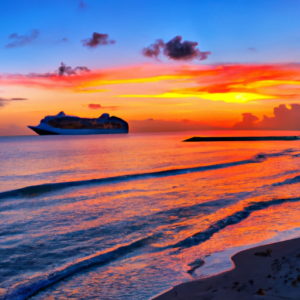Embarking on an extended journey at sea can be an exhilarating and transformative experience, but it often comes with the challenge of limited internet access and communication options. However, fear not! This article aims to provide you with tips and tricks on staying connected while sailing the open waters. From understanding the ins and outs of cruise internet access to finding the best SIM cards and staying in touch with your loved ones, this guide will ensure that you remain connected throughout your maritime adventure. So, grab your compass and get ready to conquer the digital waves!
Table of Contents
Toggle1. Understanding Cruise Internet Access at Sea
1.1 Satellite Internet vs. Cellular Internet
When it comes to accessing the internet at sea, there are two primary options: satellite internet and cellular internet. Satellite internet relies on antennas and communication satellites to provide internet connectivity, while cellular internet relies on cellular networks and SIM cards.
1.2 The Challenges of Internet Access at Sea
Internet access at sea can be challenging due to factors such as distance from shore, signal interference, and limited coverage areas. Additionally, the movement of the vessel can affect both satellite and cellular connections, leading to unstable or slow internet speeds.
1.3 The Cost of Internet at Sea
Internet access at sea can be expensive, especially for satellite internet. The costs vary depending on factors such as data limits, speed requirements, and equipment installation fees. Cellular internet, on the other hand, may offer more affordable options depending on the availability of roaming agreements and local SIM cards.
1.4 Researching Available Internet Options
Before choosing an internet solution, it is essential to research and compare available options. Consider factors such as coverage area, speed, data limits, pricing plans, and customer reviews. This research will help you make an informed decision that best suits your needs and budget.
2. Choosing the Right Internet Solution
2.1 Satellite Internet Providers
When considering satellite internet, research different providers to find the one that offers the best coverage, speeds, and packages for your specific location at sea. Compare prices, data limits, and customer reviews to ensure you choose a reliable and reputable provider.
2.2 Cellular Internet Providers
For cellular internet, check with your current cellular provider to see if they offer international plans or roaming options that would allow you to use your existing SIM card. Alternatively, research local cellular providers in the ports you plan to visit to find the best options for coverage and pricing.
2.3 Evaluating Speed, Coverage, and Pricing Plans
When comparing internet solutions, consider the speed and coverage offered by each provider. Look for reviews from other sailors or maritime enthusiasts to gauge the reliability and consistency of the service. Additionally, compare pricing plans to ensure you get the best value for your money.
2.4 Considering Data Limits and Fair Usage Policies
Data limits and fair usage policies are crucial considerations when choosing an internet solution. Determine how much data you are likely to consume during your voyage and choose a plan that provides enough data without incurring excessive costs. Be aware of fair usage policies that may throttle your speeds if you exceed certain data limits.
3. Preparing for Internet Access
3.1 Checking if Your Device is Compatible
Before setting sail, ensure that your devices, such as smartphones, laptops, or tablets, are compatible with the chosen internet solution. Check if you need any specific adapters or software installations to connect to the internet at sea.
3.2 Understanding Equipment Requirements
Depending on the chosen internet solution, you may need to install specific equipment, such as satellite dishes or cellular signal boosters, on your vessel. Understand the equipment requirements and ensure you have the necessary tools and knowledge to install them correctly.
3.3 Securing Your Network Connection
When accessing the internet at sea, it’s crucial to secure your network connection to protect your data and privacy. Ensure that your devices have up-to-date antivirus software, strong passwords, and encryption protocols enabled to safeguard against potential threats.
3.4 Testing the Internet Access on a Trial Basis
Before embarking on a long voyage, test the internet access on a trial basis to ensure it meets your expectations and requirements. This trial will allow you to identify any potential issues or limitations and make necessary adjustments, ensuring a more seamless connectivity experience during your journey.
4. Making the Most of Cellular Internet Access
4.1 Enabling International Roaming
If your cellular provider offers international roaming options, consider enabling this feature before setting sail. International roaming allows you to use your existing SIM card and data plan while in foreign ports, saving you the hassle of purchasing local SIM cards.
4.2 Purchasing Local SIM Cards
Alternatively, purchasing local SIM cards can provide cost-effective cellular internet access in different ports. Research the local cellular providers in each port and purchase a SIM card with a data plan that offers sufficient coverage and affordable rates.
4.3 Researching Cellular Providers in Different Ports
To ensure reliable cellular internet access in different ports, research the availability and quality of cellular providers in each location. Consult online forums or ask fellow sailors for recommendations to find providers with strong coverage and reliable service.
4.4 Utilizing Wi-Fi Hotspots on Land
Take advantage of Wi-Fi hotspots available on land to conserve cellular data while in port. Many restaurants, cafes, and marinas offer Wi-Fi access, allowing you to enjoy faster speeds and save your cellular data for when you are at sea.
5. Maximizing Satellite Internet Access
5.1 Installing Satellite Equipment
If you choose satellite internet, ensure that the satellite equipment is installed correctly to optimize signal strength and minimize obstructions. Seek professional assistance if needed to align the satellite dish properly for the best connectivity experience.
5.2 Understanding Signal Strength and Obstructions
Satellite internet signals can be affected by various obstructions, such as tall structures, trees, or adverse weather conditions. Familiarize yourself with signal strength indicators on your satellite equipment and position your vessel to minimize obstructions for a more stable and reliable connection.
5.3 Using Signal Boosters and Antennas
Consider using signal boosters or additional antennas to enhance the signal strength of your satellite internet connection. These devices can help amplify weak signals and improve overall connectivity, especially in areas with limited coverage.
5.4 Aligning the Satellite Dish Properly
Properly aligning the satellite dish is crucial for optimal satellite internet performance. Take the time to understand the process and ensure that the dish is aligned correctly by referring to manufacturer guidelines or seeking professional assistance if necessary.
6. Managing Internet Usage at Sea
6.1 Optimizing Data Usage
Internet usage at sea can be limited due to data caps or fair usage policies. To optimize data usage, prioritize essential activities such as navigation or communication apps. Disable automatic updates or large file downloads to prevent excessive data consumption.
6.2 Scheduling Activities that Require Less Bandwidth
To manage limited bandwidth effectively, schedule activities that require less data during times when the internet connection is slower, such as early mornings or late evenings. This will help ensure that your important tasks are completed efficiently without using up excessive data.
6.3 Using Offline Communication Alternatives
In situations where internet access is limited or unavailable, it is essential to have alternative means of communication. Utilize offline communication methods such as VHF radios, satellite phones, or handheld GPS devices to stay in touch or seek assistance when needed.
6.4 Limiting Streaming and Video Calls
Streaming videos or making video calls can quickly deplete internet data. Consider limiting these activities or utilizing lower-quality streaming options to conserve data during your voyage. Opt for audio calls or text messages when possible to reduce bandwidth consumption.
7. Staying in Touch with Loved Ones
7.1 Utilizing Voice and Video Call Applications
Stay connected with loved ones by utilizing voice and video call applications such as Skype, WhatsApp, or Facetime. These apps allow you to communicate in real-time, bridging the distance between you and your family or friends.
7.2 Sending Emails and Instant Messages
Emails and instant messaging apps provide convenient ways to stay in touch with loved ones, even with intermittent internet access. Compose thoughtful emails or send instant messages to keep them updated on your adventures and exchange important information.
7.3 Sharing Photos and Updates on Social Media
Share your experiences at sea with friends and family by uploading photos and updates on social media platforms such as Facebook, Instagram, or Twitter. Use low-resolution images or compress them to conserve data while still giving your loved ones a glimpse into your journey.
7.4 Planning Virtual Family Gatherings
Even when physically apart, technology allows for virtual gatherings and celebrations. Plan virtual family gatherings or events using video conferencing platforms, where you can share stories, laughter, and create cherished memories despite being miles away.
8. Understanding Emergency Communication
8.1 Carrying a Satellite Phone
In case of emergencies, it is essential to carry a satellite phone. Satellite phones provide reliable communication even in remote areas without cellular coverage. Research and invest in a satellite phone that best suits your needs and ensure it is always charged and accessible.
8.2 Registering for Emergency Communication Services
Some countries or regions may require registration for emergency communication services. Research the specific regulations or guidelines for the areas you plan to visit and ensure compliance to facilitate potential emergency communication.
8.3 Familiarizing Yourself with Distress Signals
Familiarize yourself with distress signals and emergency protocols to ensure effective communication in critical situations. Study internationally recognized distress signals and educate your crew on the proper use of emergency communication equipment.
8.4 Creating an Emergency Communication Plan
Develop an emergency communication plan that includes contact details for emergency services, coast guard, and designated emergency contacts. Share this plan with your crew and ensure everyone understands their roles and responsibilities during emergencies.
9. Tips for Better Internet Access at Sea
9.1 Positioning the Boat for Improved Signal
Experiment with different boat positions to find the optimal location for improved internet signal strength. Adjust your vessel’s orientation or move to areas with less obstruction to maximize connectivity while at sea.
9.2 Upgrading Antennas and Routers
Consider upgrading your antennas and routers to enhance your internet signal and coverage. High-quality antennas and routers designed for maritime use can help improve your internet access and overall connectivity experience.
9.3 Securing a Backup Internet Option
To ensure uninterrupted internet access, consider securing a backup internet solution such as a different cellular provider or a secondary satellite internet provider. This backup option will provide peace of mind in case your primary internet connection experiences issues.
9.4 Seeking Local Knowledge and Recommendations
When visiting different ports, seek local knowledge and recommendations regarding internet access. Talk to locals, marina staff, or fellow sailors to gather information about the best internet providers, coverage areas, and any reliable workarounds for connectivity issues.
10. Final Thoughts
10.1 Embracing the Adventure and Disconnecting
While internet access at sea is valuable for communication and daily tasks, it is also crucial to embrace the adventure and disconnect from the online world. Take the opportunity to immerse yourself in the beauty of the open sea and enjoy the moments of solitude and connection with nature.
10.2 Building a Balanced Relationship with Technology
Finding a balance between staying connected and disconnecting is essential for a fulfilling voyage at sea. Limit your screen time and prioritize in-person interactions with your crew and the natural wonders around you for a more enriching experience.
10.3 Enjoying the Intermittent Connectivity
Internet access at sea can be intermittent, and that’s part of the charm of a maritime adventure. Embrace the occasional disconnection and use it as an opportunity to reflect, engage in offline activities, or simply admire the breathtaking landscapes that surround you.
10.4 Considering Future Advances in Maritime Internet
Stay informed about the advances in maritime internet connectivity. As technology continues to evolve, future innovations may offer even more reliable and affordable options for internet access at sea. Keep an eye on industry developments and be open to adopting new solutions that enhance your connectivity experience while sailing.





